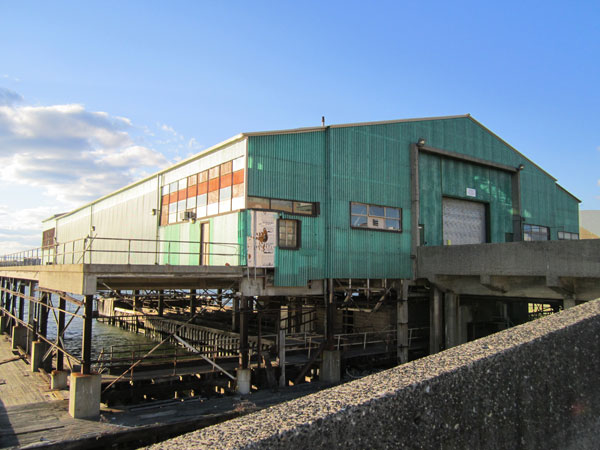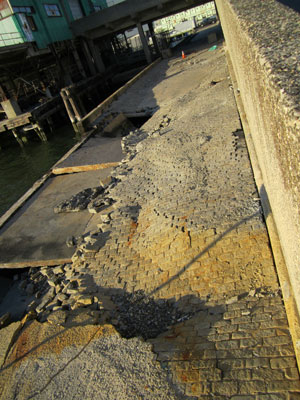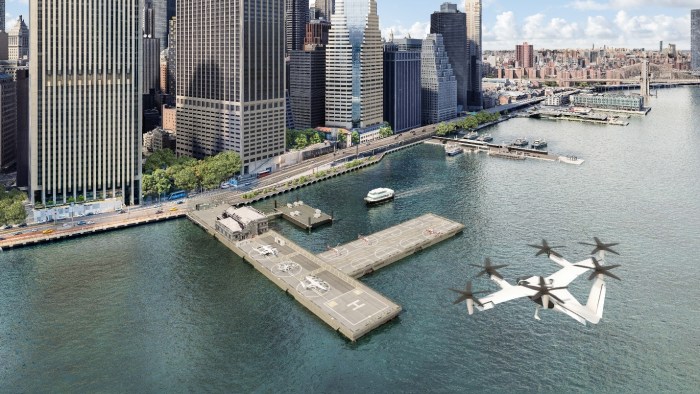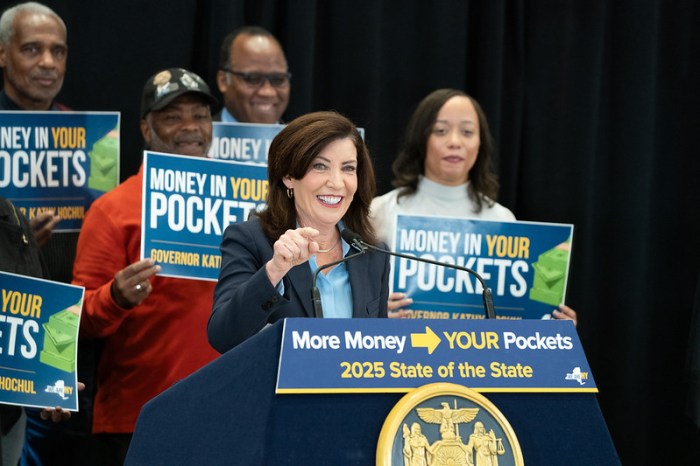
BY LINCOLN ANDERSON | It’s been five years since the state Legislature approved legislation to allow a marine waste transfer station on Gansevoort Peninsula in the Hudson River Park.
However — as the clock winds down on the final weeks of the Bloomberg administration — a crucial memorandum of understanding required to allow the hotly debated Gansevoort project to proceed still has not been signed.
Under the outgoing mayor’s Solid Waste Management Plan, or SWAMP, the peninsula was slated to become Manhattan’s sole marine waste transfer point for all recyclables from residential buildings — paper, glass, plastic and metal.
Under the scheme, up to 60 garbage trucks per day would haul recyclables to Gansevoort, where they would dump their loads into barges, which would then ferry the waste to a new recycling plant to be built in Sunset Park, Brooklyn. About 1.36 acres of the 8-acre peninsula would be set aside for a 25-foot-wide road for the trucks that would ramp up to the new transfer station. The Gansevoort facility would also have an “educational component,” teaching about recycling.
The plan immediately sparked intense opposition in the Village when it was first broached publicly in 2004. The prospect of dozens of garbage trucks per day crossing the park’s bikeway and pedestrian path would make the peninsula unfit for park use, they argued, also expressing concern about air pollution from the convoy of trucks’ diesel exhaust.
Located in the angle between Little W. 12th and Gansevoort Sts., the peninsula is not a pier but the remnant of a broad swath of landfill created in the mid-1800s that once stretched from W. 10th St. up to the mid-W. 20s, extending out to what was then called 13th Ave. (The landfill eventually had to be cut back to allow increasingly larger ships to dock.)

Formerly an incinerator
During its history, Gansevoort has been home, first, to an important open-air farmers’ market, followed next by a municipal waste incinerator and, currently, a Department of Sanitation garage and salt pile.
The Hudson River Park Act of 1998 stated that all of Gansevoort Peninsula is to be developed into an 8-acre public park as part of the larger Hudson River Park. To permit a new marine waste transfer station, an amendment or new legislation was needed since the Park Act bars municipal uses from the park.
The state Senate passed the necessary legislation by a vote of 53 to 8 in July 2007. Over the strident objections of local Assemblymembers Deborah Glick and Richard Gottfried, the Assembly passed it by 91 to 48 in June 2008.
The City Council also backed “reactivating” the Gansevoort marine waste transfer station by a 48-to-3 vote. Christine Quinn had kept neutral on the issue when she was just a councilmember, but then supported the Gansevoort transfer station after becoming Council speaker in 2006.
Joining Bloomberg and other elected officials — many of them black and Latino — at a press conference at Gansevoort in June 2007, Quinn said the proposed transfer facility would be compatible with park use at the peninsula.
“It’s fair,” she said. “We’re done with putting noxious uses in the outer boroughs and communities of color.”
“There is no other place for it,” Bloomberg said then. “If this doesn’t happen, we’ll keep polluting our air.”
A Gansevoort marine waste transfer station, combined with another one for commercial waste — primarily from restaurants — at Pier 99, at W. 59th St., would cut more than 5,000 Sanitation truck trips per year, the Bloomberg administration said at the time.
‘Plan is environmentally just’
A talking point in The Villager in October 2004 by a citywide coalition called Organization of Waterfront Neighborhoods, or OWN, noted that they had been pushing the city to adopt some kind of plan like SWAMP as an “environmentally just, marine-based system for handling and minimizing our waste. Our coalition,” they noted, “includes representatives of the three New York City neighborhoods that bear the brunt of the city’s current waste management system: Greenpoint/Williamsburg, the South Bronx and Southeast Queens.” A Gansevoort M.W.T.S., they continued, “would…help to ensure that waste generated in Manhattan does not continue to be trucked to the outer boroughs, and it would also help reduce the amount of long-haul truck traffic on Manhattan streets, including on the Canal St. corridor.”
Generating even more opposition has been another component of SWAMP, the reactivation of a marine waste transfer station on the Upper East Side at E. 91st St.
In 2010, the city issued a request for proposals, or R.F.P., for designs for a new Gansevoort waste transfer station.
Meanwhile, the new Sunset Park recycling facility that would receive the barged waste was reportedly set to open last month, according to a September article in The New York Times.
M.O.U. is M.I.A.
But, specifically, before the Gansevoort M.W.T.S. agreement becomes final, the mayor, governor and leaders of the Assembly and state Senate still must all sign a memorandum of understanding, or M.O.U., about either replacing or paying for the parkland that the M.W.T.S. “alienates” — as in, removes from public use — on the peninsula.
More than a year ago, during a discussion with The Villager about another thorny park issue, Pier 40, Madelyn Wils, president of the Hudson River Park Trust, let slip that the M.O.U. for the transfer station on Gansevoort was still unsigned. She didn’t want to go more into detail about it just then, noting that it was “another story.”
A couple of weeks ago, The Villager asked Wils again about the status of the Gansevoort marine waste transfer station. She replied that the M.O.U. remains unsigned to this day. She said that the terms of the M.O.U. — or at least the terms that the Trust itself would like to see — are that the Trust would be paid $50 million for alienation of the parkland needed to allow the transfer station.
As soon as the new three-district Department of Sanitation garage is finished in Hudson Square, at Spring and Washington Sts., Wils said, the garbage trucks from Gansevoort will all be moved down there. The Spring St. facility is already substantially built — with finishing touches now being put on it — and is slated for completion in spring 2014.
Wils said that, once the garbage trucks vacate Gansevoort, it would take about a year to get the peninsula in shape before anything can be done on it. Some environmental remediation would no doubt be needed, since it was once home to a garbage incinerator.
Gottfried skeptical on action
However, Assemblymember Gottfried — who co-authored the Hudson River Park’s founding legislation — last week told The Villager he doubts there will be any action taken on the M.O.U. for the Gansevoort transfer station in the final two months of Mayor Bloomberg’s administration.
“I mean, there have been drafts for years that are sitting in a drawer,” the assemblymember said of the Gansevoort M.O.U. “I haven’t heard anything about it stirring to life recently. I don’t think anyone has signed it. I think it’s been sitting around for several years. I haven’t heard anyone talk about it in a really long time. I don’t think anyone has actually seen it, and I don’t think any governor or mayor has actually agreed to it.”
Even if Bloomberg tried to push for the M.O.U. to be signed now, Gottfried said, Assembly Speaker Sheldon Silver would not rush things, since he “would want a fair and public review.”
“I don’t know that Silver would be interested in taking that up in the closing days of the [Bloomberg] administration,” Gottfried stated. “I haven’t asked him about it because I haven’t heard anything about it for a very long time.”
Told about Wils having cited a $50 million compensation figure, Gottfried said, “That’s certainly in the ballpark.”
However, he noted, while the 2007 legislation making an M.W.T.S. an allowable use at Gansevoort does mention financial compensation, it doesn’t give a dollar figure.
It’s de Blasio’s decision now
In short, Gottfried confidently predicted, “What will happen with Gansevoort and the other marine transfer sites will be in the hands of our new mayor.”
As for where Bill de Blasio stands on siting a marine transfer station at Gansevoort, it’s not yet clear.
Frieda Bradlow, a former member of the city’s Solid Waste Advisory Board, said that, during the mayoral campaign, the only candidate who really came out strongly against a Gansevoort M.W.T.S. was John Liu.
“Liu was the only candidate who was specific,” she said.
Bradlow said she isn’t sure where de Blasio stands on the issue.
“It was something we never thought would make it through the Assembly,” she said of the legislation to allow the transfer station in Hudson River Park. “Chris Quinn did not oppose it,” she added.
Bradlow, 81, a longtime Villager, was one of the original members of the Solid Waste Advisory Board when it was created back in 1988. She was first appointed by then Borough President Andrew Stein. However, after she opposed the plan to have all Manhattan’s residential recyclables barged from Gansevoort, she suddenly found herself not reappointed five years ago by Borough President Scott Stringer.
“In my interview, a woman who was young enough to be my granddaughter told me I could reapply the following year,” Bradlow said.
Quinn didn’t fight M.W.T.S.
District Leader Arthur Schwartz, who has long been active on Hudson River Park issues, also opposed the Gansevoort transfer station.
“It was totally a Quinn-Bloomberg project,” he said. “She went along with the mayor. She wanted to show she was sensitive to black communities.”
Schwartz said he, too, doesn’t know where de Blasio stands on the idea of an M.W.T.S. at Gansevoort.
“I don’t know if de Blasio has ever made a statement on that,” he said. “I think it’s horrible — to put a Sanitation facility 500 feet away from a playground.”
Schwartz was referring to the Jane St. water playground just to the south.
“I mean, it’s supposed to be a beach,” he added.
Indeed, former Governor Pataki always would vow, “There will be a beach at Gansevoort Peninsula one day.”
Spectra has also recently installed a high-pressure gas pipeline across Gansevoort, but it’s buried 5 feet belowground, so people at least will be able to use the future park above it, as opposed to a roadway for a Gansevoort M.W.T.S., which would be off limits to parkgoers.
‘Gansevoort is for everybody’
Tobi Bergman, president of P3, is a leading advocate for youth sports uses at Pier 40, at W. Houston St. Back in the early days of the Hudson River Park — before the huge courtyard sports field had been created at Pier 40 — it was thought Gansevoort might be a good spot for ball fields. But now, Bergman said, the peninsula would be better suited for general park use.
“It’s a shame to put a transfer station out there,” he said. “It’s just a unique opportunity for a park for everyone. Pier 40 is a better place for ball fields, and Gansevoort is everybody’s park. It has some of the best river views in the park.”
As for alternatives for dealing with the waste, Schwartz said he backs removing trash from the city by rail. Bergman, on the other hand, noted that trash-burning technology has advanced tremendously since the days of the Gansevoort Destructor, as the incinerator there was formerly known. Europe, he said, is burning trash cleanly and using it to provide energy. Bradlow, for her part, said we should all focus much more on “waste prevention.”
































